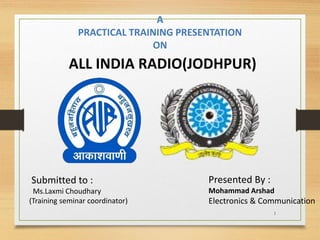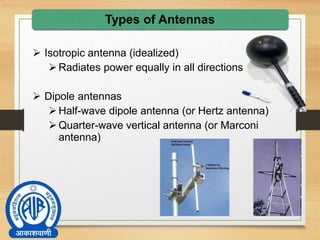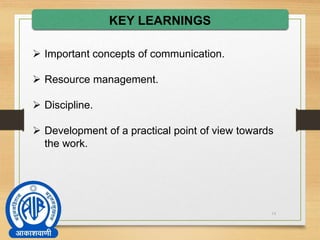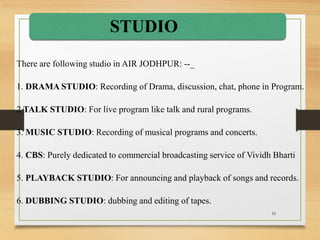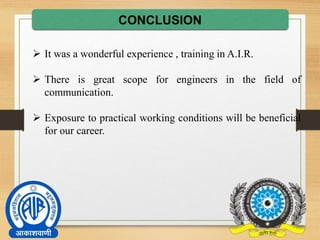Arshad all india radio PPT
- 1. 1 A PRACTICAL TRAINING PRESENTATION ON ALL INDIA RADIO(JODHPUR) Submitted to : Ms.Laxmi Choudhary (Training seminar coordinator) Presented By : Mohammad Arshad Electronics & Communication
- 2. 2 CONTENTS ’āś Introduction ’āś History and present scenario ’āś Principal of All India Radio ’āś THREE TIRE BROADCASTING SYSTEM ’āś Transmitter ’āś Studio ’āś Console ’āś Phone in Program console ’āś Conclusion
- 3. INTRODUCTION TO A.I.R 3 ’āś A.I.R is one of the largest radio networks in the world. ’āś A national service planned, developed and operated by the Prasar Bharati Broadcasting Corporation of India ’āś All India Radio, Jodhpur was established at 15th August,1965. ’āś The Satellite Earth station was established at 21st March,1944. ’āś
- 4. 4 4 ’āś To uphold the unity and integrity of the country and the values enshrined in the Constitution. ’āś Present a fair and balanced flow of information of national, regional, local and international interest, including contrasting views, without advocating any opinion or ideology of its own. ’āś Produce and transit varied programs designed to awaken, inform, educate, entertain and enrich all sections of the people. OBJECTIVE
- 5. 5 HISTORY AND PRESENT SCENERIO ’āś In 1926 the private Indian Broadcasting Company (IBC) was granted permission to operate two radio stations; the Bombay station was inaugurated on July 23, 1927, the Calcutta station followed on August 26, 1927. ’āś The introduction of the commercial channel ŌĆśVividh BhartiŌĆÖ in October 1957 increased the interest and popularity of radio.
- 6. 6 ’āś AIR today has a network of 237 broadcasting centers with 149 medium frequency (MW), 54 high frequency (SW) and 177 FM transmitters. ’āś The coverage is 91.85% of the area , serving 99.18% of the people in the largest democracy of the world. ’āś AIR covers 24 Languages and 146 dialects in home services.
- 7. 7 Principles Of All India Radio *Transmitting *A radio wave carries information signal; Signals are converted into electrical signals. A carrier wave is then produced from the modulation. The wave is then amplified, and sent to the antenna that then converts signal into an E.M. wave. *Receiving *An antenna on receiving the signal send it to the receiver this then converts the electrical signal sends it to the amplifier either a speaker/headphones jack this is then converted into a sound wave. ŌĆó Modulation ŌĆó Amplification Transmission ŌĆó Demodulation ŌĆó Amplification Reception
- 8. 8 ’āś Antenna is usually a metallic device (as a rod or a wire) used for radiating or receiving electromagnetic waves. ’āś Transmission - radiates electromagnetic energy into space ’āś Reception - collects electromagnetic energy from space ’āś In two-way communication, the same antenna can be used for transmission and reception Antenna Introduction
- 9. 9 Types of Antennas ’āś Isotropic antenna (idealized) ’āśRadiates power equally in all directions ’āś Dipole antennas ’āśHalf-wave dipole antenna (or Hertz antenna) ’āśQuarter-wave vertical antenna (or Marconi antenna)
- 10. 10 Types of Antennas ’āś Yagi uda ’āś Phased arrays ’āś Vertical or Horizontal ’āś Horns for super ultra high frequencies ’āś Mobile antennas
- 11. 11 Antenna Array ’āś Consist of multiple antennas collaborating to synthesize radiation characteristics not available with a single antenna. They are able ’āśto match the radiation pattern to the desired coverage area. ’āśto change the radiation pattern electronically through the control of the phase and the amplitude of the signal fed to each element. ’āśto adapt to changing signal conditions. ’āśto increase transmission capacity by better use of the radio resources and reducing interference. ’āś.
- 12. 12 Antenna Array 27 antennas along 3 railroad tracks provide baselines up to 35 km. Radio images are formed by correlating the signals garnered by each antenna.
- 13. 13 Advantages of Antenna Array ’āś Possibilities to control electronically ’āśDirection of maximum radiation ’āśDirections (positions) of nulls ’āśBeam-width ’āśDirectivity ’āśLevels of side lobes Using standard antennas (or antenna collections) independently of their radiation patterns. ’āś Antenna elements can be distributed along straight lines, arcs, squares, circles, etc.
- 14. 14 KEY LEARNINGS ’āś Important concepts of communication. ’āś Resource management. ’āś Discipline. ’āś Development of a practical point of view towards the work.
- 16. 16 There are following studio in AIR JODHPUR: --_ 1. DRAMA STUDIO: Recording of Drama, discussion, chat, phone in Program. 2 TALK STUDIO: For live program like talk and rural programs. 3. MUSIC STUDIO: Recording of musical programs and concerts. 4. CBS: Purely dedicated to commercial broadcasting service of Vividh Bharti 5. PLAYBACK STUDIO: For announcing and playback of songs and records. 6. DUBBING STUDIO: dubbing and editing of tapes. STUDIO
- 17. 17 CONSOLE
- 18. 18 SYSTEM FACILITIES A. Interface with telephone line B. Interface with telephone equipment C. Optional facility for headset if required D. Optional facility for direct broadcast on air using headset/handset lf required. FEATURES 1. Conversion with the remote participant in the live program. 2. Feed responses from the expert in the studio to the listeners through telephone line. 3. Facilitate live broadcast of both the listen enquiry and expert's responses. 4. Provide music on hold 5. Provide signaling facilities for indicating incoming calls.
- 19. 19 CONCLUSION ’āś It was a wonderful experience , training in A.I.R. ’āś There is great scope for engineers in the field of communication. ’āś Exposure to practical working conditions will be beneficial for our career.
- 21. 21 Thank uŌĆ”

